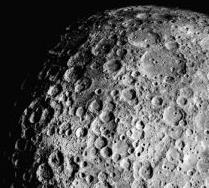History and Formation of the Moon
The young moon was still mostly molten from enormous bombardments and radioactive decay, which allowed differentiation to occur. This would only have taken a 100 million years.

PHASE 2: Cratering
The moons surface is so old, it serves as a record of the immense
bombardment occurring 4 billion yrs ago, not just with innumerable
craters, but it's surface rock is fractured to a depth of several
km! Several of the mare are actually old, very large impact craters
which have since filled with lava.
Mare Imbrium was created 3.8 billion years ago by an
asteroidal body tens of km in diameter, throwing out immense
amounts of ejecta to form the mountains ringing the basin. It
was along these southern mountains that Apollo 15 landed. Exactly
opposite the largest craters on the moons surface, we see
jumbled terrain, created by the impacts shock wave as
it traveled through and around the moon.
 PHASE 3: Flooding
PHASE 3: Flooding
The surface rock had long since solidified, and was now riddled
with craters, but below the crust the mantle was still molten.
Large impacts cracked the crust, resulting in lava flows in the
low lying regions. Many areas show evidence for multiple flows,
spread out over a billion years.
Curiously, the far side of the moon looks quite different than the
side we always see. It shows few maria. The crust is thicker on
the far side, keeping the molten mantle from seeping through even
when large impacts have hit the moon there.
PHASE 4: Surface Evolution
Without active geology, water or wind, the surface evolution of
the moon has been minimal. Most of the 'weathering' has been caused
by micro-meteorites 'sand-blasting' the surface.
How did we get such a big moon?
Fission. The moon spun off the Earth after Earth had already
been partially differentiated (making the Moon low density). However
the moons orbit is not aligned with Earth's equator.
Co-accretion. The moon and Earth formed as a binary. But
this does not explain their differing chemical composition (little
Fe in the Moon, though they do have similar ratios of light elements).
Capture The moon was later captured by Earth. This requires
forming the Moon else where (near the Sun to get the right composition).
The Earth could not easily capture something this massive.
 Large-Impact Hypothesis
Large-Impact Hypothesis
At the time Earth formed 4.5 billion years ago, other smaller planetary
bodies were also growing. One of these hit earth late in Earth's growth
process, blowing out rocky debris. A fraction of that debris went into orbit
around the Earth and aggregated into the moon. This theory explains the
Moon chemistry very well, if the collision occurred after the Earth had
differentiated and moon volatiles (water) were lost to space.